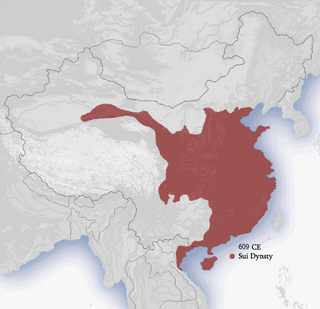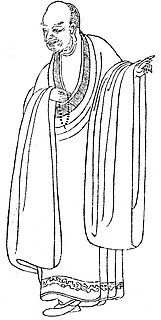The Four Paragons of the Early Tang (Chinese :初唐四傑; pinyin :Chū Táng Sì Jié) is a group name for four Chinese poets of the early Tang dynasty: Luo Binwang, Lu Zhaolin, Wang Bo, and Yang Jiong. [1]

Traditional Chinese characters are Chinese characters in any character set that does not contain newly created characters or character substitutions performed after 1946. They are most commonly the characters in the standardized character sets of Taiwan, of Hong Kong and Macau, and in the Kangxi Dictionary. The modern shapes of traditional Chinese characters first appeared with the emergence of the clerical script during the Han Dynasty, and have been more or less stable since the 5th century.
Hanyu Pinyin, often abbreviated to pinyin, is the official romanization system for Standard Chinese in mainland China and to some extent in Taiwan. It is often used to teach Standard Mandarin Chinese, which is normally written using Chinese characters. The system includes four diacritics denoting tones. Pinyin without tone marks is used to spell Chinese names and words in languages written with the Latin alphabet, and also in certain computer input methods to enter Chinese characters.

The Tang dynasty or the Tang Empire was an imperial dynasty of China spanning the 7th to 10th centuries. It was preceded by the Sui dynasty and followed by the Five Dynasties and Ten Kingdoms period. Historians generally regard the Tang as a high point in Chinese civilization, and a golden age of cosmopolitan culture. Tang territory, acquired through the military campaigns of its early rulers, rivaled that of the Han dynasty. The Tang capital at Chang'an was the most populous city in the world in its day.
According to a Tang biography of Yang Dong, the four people enjoyed same popularity and fame in China. They thrived in the time of Emperor Gaozong.

Emperor Gaozong of Tang, personal name Li Zhi, was the third emperor of the Tang dynasty in China, ruling from 649 to 683. Emperor Gaozong was the son of Emperor Taizong and Empress Zhangsun.
The Four Eminences abolished the Gongti Style which had been used since the Southern Qi and Liang dynasty. The Wǔyán Lǜshī (Chinese: 五言律詩) passed through a critical phase of development under the four people's influence.

The Southern Qi (479-502) was the second of the Southern dynasties in China, followed by the Liang Dynasty. During its 23-year history, the dynasty was largely filled with instability, as after the death of the capable Emperor Gao and Emperor Wu, Emperor Wu's grandson Xiao Zhaoye was assassinated by Emperor Wu's intelligent but cruel and suspicious cousin Xiao Luan, who took over as Emperor Ming, and proceeded to carry out massive executions of Emperor Gao's and Emperor Wu's sons and grandsons, as well as officials whom he suspected of plotting against him. The arbitrariness of these executions was exacerbated after Emperor Ming was succeeded by his son Xiao Baojuan, whose actions drew multiple rebellions, the last of which, by the general Xiao Yan led to Southern Qi's fall and succession by Xiao Yan's Liang Dynasty.

The Liang dynasty (502–557), also known as the Southern Liang dynasty (南梁), was the third of the Southern Dynasties during China's Southern and Northern Dynasties period. It was located in East China and South China, and replaced by the Chen dynasty in 557. The small rump state Western Liang (555–587), located in Central China, continued until its annexation in 587.
Lüshi refers to a specific form of Classical Chinese poetry verse form. One of the most important poetry forms of classical Chinese poetry, the lüshi refers to an eight-line regulated verse form with lines made up of five, six, or seven characters; thus:
The rank of the Four Eminences has been the spotlight of discussion. Yang Jiong expressed his unwillingness to be put behind Wang Bo and in front of Lu Zhaolin. [2]

Yang Jiong was a Tang dynasty Chinese poet, traditionally grouped together with Luo Binwang, Lu Zhaolin, and Wang Bo as the Four Paragons of the Early Tang. Known for his eight extant fu (rhapsody) poems, he also wrote an influential preface to the collected works of Wang Bo, in which he criticized the excessive formality of the court poetry of the preceding generation, and lauded the classical style of Wang Bo and Lu Zhaolin.

Wang Bo, courtesy name Zi'an (子安), was a Tang dynasty Chinese poet, traditionally grouped together with Luo Binwang, Lu Zhaolin, and Yang Jiong as the Four Paragons of the Early Tang. He died at the age of 26, possibly from drowning, while going to Jiaozhi to meet his father.

Lu Zhaolin, courtesy name Shengzhi, was a Tang dynasty Chinese poet, traditionally grouped together with Luo Binwang, Wang Bo, and Yang Jiong as the Four Paragons of the Early Tang.










